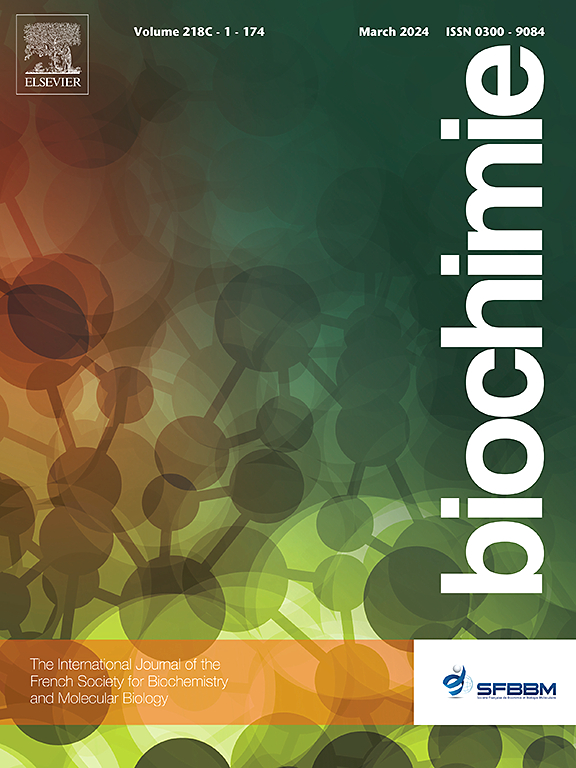Convergence of plant sterols and host eukaryotic cell-derived defensive lipids at the infectious pathogen-host interface
IF 3.3
3区 生物学
Q2 BIOCHEMISTRY & MOLECULAR BIOLOGY
引用次数: 0
Abstract
Plant sterols (PSs) exhibit intrinsic functions such as antibacterial effects. Their effects simultaneously on both host-mediated and bacteria-mediated pathogenesis are not yet fully understood. We hypothesized that when absorptive cells, defensive cells and detoxer cells are cultured together, their convergent response to an infectious pathogen depends on the molecular mimicry between the ingested sterols and their own defensive lipids. A human triple cell co-culture model incorporating colonocytes, macrophages, and hepatocytes was established. Cocultures were stimulated with Klebsiella pneumoniae 52145 (Kp52145) in the presence of pure plant sterol (β-sitosterol, PS) for 6 h. Changes in the structural health markers of the stimulated cocultured cells and their immune response and biochemical markers of pathogenicity were determined. PS significantly inhibited the secretion of cytokines induced by Kp52145. Cell viability was higher in the Kp52145 + PS group compared to the Kp52145 alone group. PS decreased Kp52145-induced marker of pathogenicity (SOD), accompanied by reduced levels of interleukin-1β (IL-1β), interleukin-6 (IL-6), mannose binding lectin (MBL), and pentraxin 3 (PTX3) which are the mediators and enzymes associated with the inflammatory response to an infectious-inflamed milieu. PS recovered Kp52145-decreased peroxidase (POX), catalase (CAT), complement component 3 (C3), and high-density lipoprotein cholesterol (HDL-C) values. Convergence of ingested plant sterols and host eukaryotic cell-derived defensive lipids mitigates the disruptive effects of bacterial toxic effector molecules. Structural or immunological similarities (molecular mimicry) between ingested plant sterols and host defensive lipids play an important role in modulating bacterial signalling that occurs at the pathogen-host interface and in the mitigation of infection- and inflammation-driven pathological processes.
植物甾醇和宿主真核细胞源性防御脂类在感染性病原体-宿主界面的聚合。
植物甾醇具有抗菌等内在功能。它们同时对宿主介导和细菌介导的发病机制的影响尚不完全清楚。我们假设,当吸收细胞、防御细胞和解毒细胞一起培养时,它们对感染性病原体的趋同反应取决于摄入的固醇和它们自身的防御脂质之间的分子模拟。建立了人结肠细胞、巨噬细胞和肝细胞三细胞共培养模型。用肺炎克雷伯菌52145 (Kp52145)在纯植物甾醇(β-谷甾醇,PS)存在下刺激共培养6小时。测定受刺激共培养细胞的结构健康指标及其免疫应答和致病性生化指标的变化。PS显著抑制Kp52145诱导的细胞因子分泌。与单独作用Kp52145组相比,Kp52145+PS组细胞活力更高。PS降低了kp52145诱导的致病性标志物(SOD),同时降低了白细胞介素-1β (IL-1β)、白细胞介素-6 (IL-6)、甘露糖结合凝集素(MBL)和戊素3 (PTX3)的水平,这些物质是感染炎症环境中与炎症反应相关的介质和酶。PS恢复了kp52145降低的过氧化物酶(POX)、过氧化氢酶(CAT)、补体成分3 (C3)和高密度脂蛋白胆固醇(HDL-C)值。摄入的植物甾醇和宿主真核细胞来源的防御性脂质的收敛减轻了细菌毒性效应分子的破坏性作用。摄入的植物甾醇和宿主防御性脂质之间的结构或免疫学相似性(分子模仿)在调节病原体-宿主界面发生的细菌信号传导和减轻感染和炎症驱动的病理过程中发挥重要作用。
本文章由计算机程序翻译,如有差异,请以英文原文为准。
求助全文
约1分钟内获得全文
求助全文
来源期刊

Biochimie
生物-生化与分子生物学
CiteScore
7.20
自引率
2.60%
发文量
219
审稿时长
40 days
期刊介绍:
Biochimie publishes original research articles, short communications, review articles, graphical reviews, mini-reviews, and hypotheses in the broad areas of biology, including biochemistry, enzymology, molecular and cell biology, metabolic regulation, genetics, immunology, microbiology, structural biology, genomics, proteomics, and molecular mechanisms of disease. Biochimie publishes exclusively in English.
Articles are subject to peer review, and must satisfy the requirements of originality, high scientific integrity and general interest to a broad range of readers. Submissions that are judged to be of sound scientific and technical quality but do not fully satisfy the requirements for publication in Biochimie may benefit from a transfer service to a more suitable journal within the same subject area.
 求助内容:
求助内容: 应助结果提醒方式:
应助结果提醒方式:


